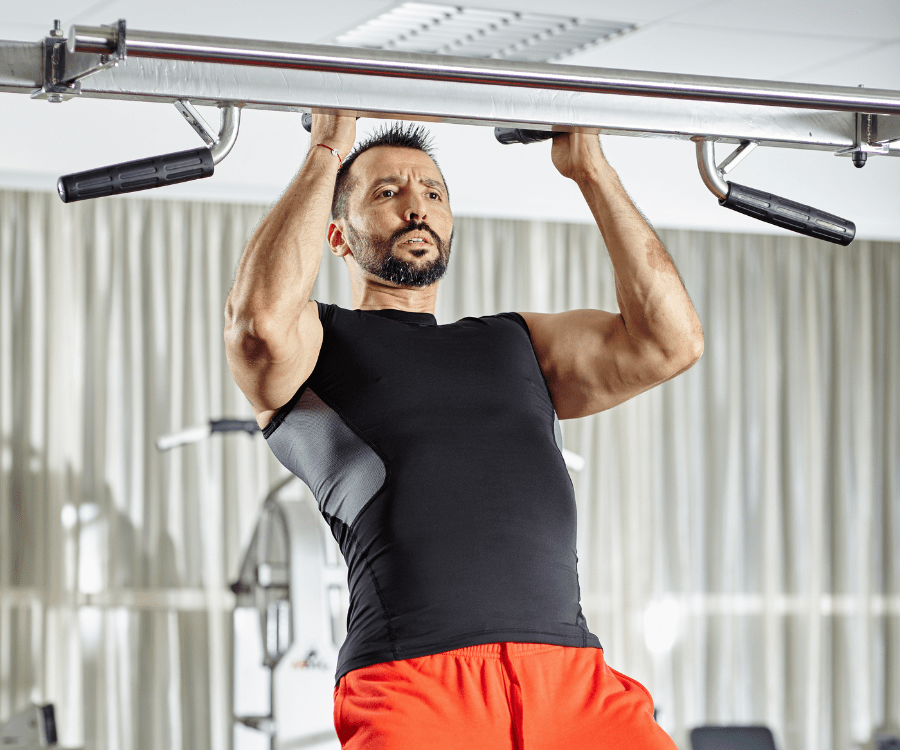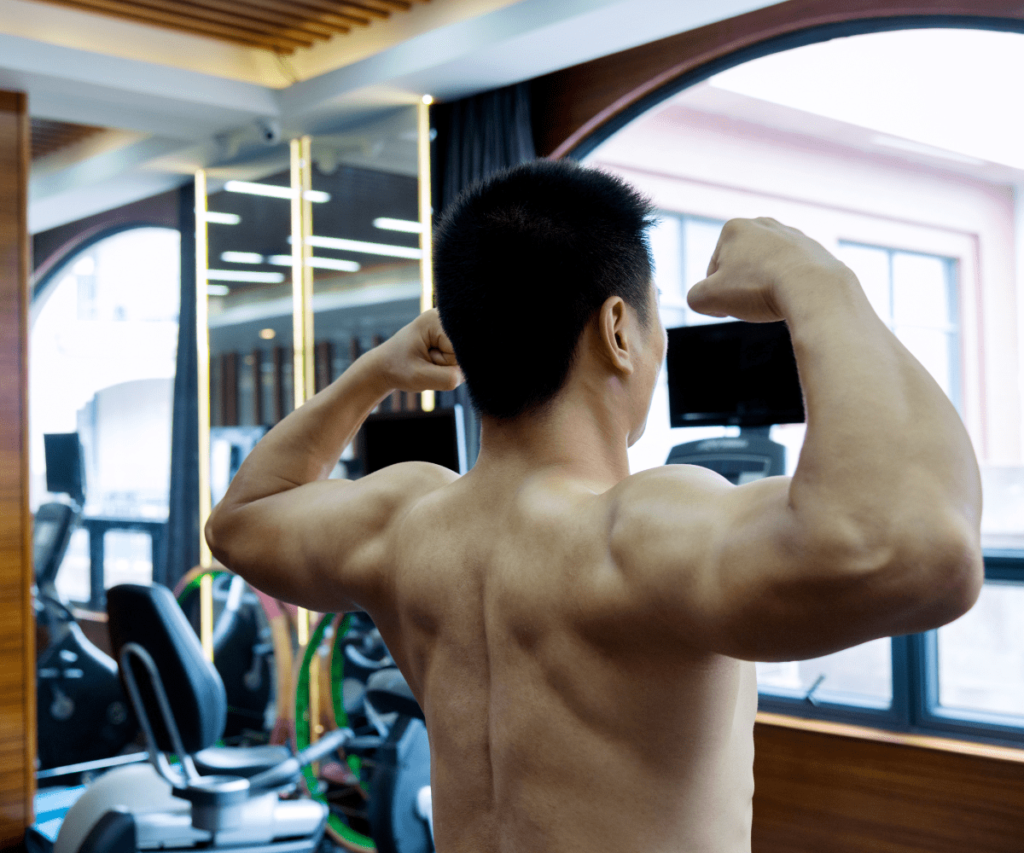Wondering if a neutral grip is better for pull-ups? We discuss everything you need to know about this variation and when you should consider using it (if ever).

Reviewed by Brian Richards, CPT, CSCS. Last updated 15th December.

The pull-up is a fantastic, body weight exercise. Typically, you either love them or hate them.
Luckily, there are a few variations, including some that are easier than others. The neutral grip pull-up is a prime example of a strict, pulling movement that may be easier for some people. But don’t worry, this will still leave you with a great work out, a defined upper back, and rock-solid pulling strength.
A neutral grip pull-up can be considered one of the easier pull-up variations. It is performed very similar to a standard pull-up but with the palms of your hands facing each other. When your palms are facing each other, you will have a neutral position at your wrist, elbow, and shoulder, giving it the name, neutral grip pull-up. Otherwise this variation is performed the same as a standard, overhand pull-up.
You might be wondering why would someone want to do neutral grip pull-ups?
Performing this version may allow you to perform more volume when compared to the standard pull-up, allowing you to build more pulling strength, endurance, and definition of your upper back and arms.
Muscles Used in Neutral Grip Pull-Ups
Neutral grip pull-ups require strength from nearly all of our upper body muscles. From your forearms to your lats, you are sure to see and feel the strength gains when you incorporate these into your workout program.
In your forearm you are using all of your wrist flexors to maintain a solid grip on the bar or handles:
- Flexor Carpi Ulnaris
- Flexor Carpi Radialis
- Palmaris Longus
- Flexor Digitorum Superficialis and Profundus
At your upper arm you are using your:
- Pectoralis Major and Minor
- Biceps and Brachioradialis
- Triceps
- Middle and Posterior Deltoids
- Rotator Cuff
In your back you are using your:
- Middle and Lower Trapezius
- Rhomboids
- Latissimus Dorsi
So far research has shown that there is actually little difference in activation of these muscle groups in different variations of the pull-ups. Only one significant finding was found:
There is a slight difference in middle trapezius activation, with more activation during standard pull-ups when compared to a neutral grip pull-up.
In the same study, there was slightly more middle deltoid, biceps, and pec major activation during a neutral grip pull-up compared to an over or underhand grip. But these findings were not considered significant.
There are just some anatomical, person to person differences, that make neutral grip pull-ups easier for some people.
How to Perform Neutral Grip Pull-Ups
Now that you know what muscle groups are most active in a neutral grip pull-up, it is time to learn how to perform one. The basics of a pull-up are to hang from something and use your upper body strength to pull your chin over the bar. But of course, there is much more to it than simply pulling yourself up.
To make it easier to follow, we will break up the neutral grip pull up into 3 phases:
- Starting position
- Concentric pull
- Eccentric lowering
- Starting position
Hang from an overhead bar with handles that are parallel to each other, allowing you to hold your hands in a neutral grip, slightly wider than shoulder width position.
This is considered an “active hanging” position, meaning you are using the muscles of your upper back and arms to actively hang onto the bar versus “dangling” from the bar. Think of using your middle and lower traps, lats, pecs, and all of the other muscles previously listed to keep you in a strong hold at the beginning, hang position.
Your elbows should be straight and your feet should be off of the ground, allowing your arms, core, hips, and the rest of your leg to be in a strong, neutral position.
Concentric Pull
As you transition from the active hang into the pulling motion, you should maintain a strong, neutral midline. The muscles around your upper back and shoulder blade will engage even more to depress, retract, and rotate your shoulder blades. Your elbows will start to bend and the strength of your grip will increase.
You will keep pulling yourself up by using more and more of the muscles around your upper back and shoulders while keeping your body moving in a straight, linear path until your chin is over the bar.
Avoid cranking your neck into extension or swinging your body to try and help getting your chin over the bar. Put a lot of emphasis on squeezing your shoulder blades and using your lats to help power the movement.
Keep this concentric pull smooth and controlled. Once your chin is over the bar you will begin the eccentric lowering phase of the neutral grip pull-up.
Eccentric Lowering
Maintaining control and a strong, neutral midline are key to a successful lowering portion of the pull-up. Your elbows will extend and your shoulder blades will return to the starting position. This will require eccentric strength of all of the muscles of your upper back and shoulders to ensure you do not quickly drop down to the bottom of the pull-up, into a “dead” hang. Instead, we want to lower down into an “active” hang. This will help to facilitate the next repetition of your neutral grip pull-up.
Benefits of Neutral Grip Pull-Ups
Neutral grip pull-ups may feel easier to some people when compared to standard pull-ups. As mentioned earlier, this could be because there is less work through the middle trapezius and more work through the middle deltoid, biceps, and pec major, which tend to be stronger muscles than the trapezius muscle groups.
This may allow someone to perform more pull-ups in a row when compared to other pull-up variations, allowing more strength gains in a shorter amount of time.
Also, the neutral grip pull-up keeps your whole arm in a neutrally rotated position. This may seem obvious as the word neutral is in the name. But a neutrally rotated arm position means you are keeping the tendons of your rotator cuff and the whole shoulder joint in a happier and healthier position.
When performing underhand grip pull-ups, your whole arm is externally rotated. Or when performing overhand grip pull-ups, your whole arm is internally rotated. If any of these positions are painful, or if you are dealing with a shoulder injury, a neutral grip may allow you to continue to work on pull-ups without any pain or limitations.
Plus, neutral grip pull-ups adds variety to your standard upper back and arm workout routine. While other pull up variations are also great, it is best to have a variety of exercises in order to avoid a plateau.
So, keep neutral grip pull-ups in mind when you are wanting to build upper back and arm pulling strength, if you are dealing with a shoulder injury, and to be able to add variety to your training program.
Neutral Grip Pull-Ups vs Chin Ups
We previously mentioned the underhand grip pull-up. This is also called a chin up. Maybe you have memories from grade school, where you had to perform as many chin ups as you could. Or maybe you had a competition to see who could hold a chin up the longest.
The biggest difference between the neural grip pull-up and a chin up is the hand position, one is neutral and the other is an underhand grip. Your grip will also be slightly narrower in a chin up exercise.
This narrower, underhand grip means you are performing a more pulling motion, bringing your elbows in front of your body. During a neutral grip pull-up, you will notice that the slightly wider grip brings your elbows down next to your body. This is an extension movement versus an adduction movement, meaning you are working the same muscles used in both movements but in slightly different planes of motion.
Being in this underhand, chin up position will require you to use the biceps more than during the neutral grip pull-up. This will most likely make chin ups easier to perform than neutral grip or standard overhand pull-ups, allowing you to build strength more easily. With the stronger pull from the biceps you will notice more strength gains in your biceps compared to other types of pull-ups.
As always, a variety of workouts is best, so make sure to include both neutral grip pull-ups, chin ups, and any other pull-up variation that you can do with good form and no pain.
Summary
Ultimately, personal preference and fitness goals will influence which hand grip is best suited when doing pull-ups.
If you’ve never tried a neutral grip before, you may find it easier compared to a wide overhand grip, which means you may find you can do more repetitions, leading to better muscle growth.
